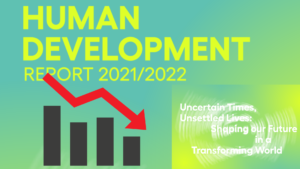 The UN’s 2022 HDI report reveals India remains at the bottom pile of countries in health, education and income levels – far behind the global averages in human development parameters
The UN’s 2022 HDI report reveals India remains at the bottom pile of countries in health, education and income levels – far behind the global averages in human development parameters
Human capital development is critical for the growth and development of any economy, but that is where India remains a global outlier, in spite of having entered the “Amrit Kaal” and becoming the fifth-largest economy in 2022. The latest Human Development Index (HDI) of the UN, released last week, confirms this, notwithstanding the fact that the pandemic impacted all countries adversely. Poor quality of human resources alone would prevent India from capitalizing on its demographic opportunity – 27.2% of the young population (15-29 years in 2021) in a rapidly ageing world.
The HDI measures health (life expectancy), education (years of schooling) and income (per capita) and hence, measures the “development of a country”, rather than just economic growth (income or GDP). The UN report shows India’s rank remains abysmally low (in 2021) at number 132 among 191 countries – falling from 131 of 189 countries in 2020. Its (composite) score of 0.633 (on a 0-1 scale) is well below the global average of 0.732. The top 28 countries score more than 0.9. Even Bangladesh has a higher score of 0.661.
Let this sink in for what that indicates.
The disaggregate score reveals India’s global standing is even worse in health and education. In health (life expectancy), it stands at 135 with a life expectancy of 67.2 years. The world average is 71.4 years. Bangladesh at 72.4 years scores above India. In education (mean years of schooling), India stands at 139 with average schooling years of 6.7 years, while the global average is 8.6 years. Bangladesh scores much higher than India at 7.4 years. In income (GNI per capita 2017 PPP in $), India is a little better and stands at 126 ($6,590) and higher than Bangladesh ($5,472), but the global average is $16,572 – 2.5 times more than India’s.
The HDI also reveals another dark side of India: high inequality.
The higher the inequality, the greater the threat to sustained growth and better socio-economic outcomes. Like all averages, HDI masks inequality in the distribution of human development across the population. Called inequality-adjusted HDI (IHDI), India’s (composite) score in it is 0.475 (on a 0 to 1 scale) – a loss of 25% from the HDI score. The global average of IHDI is 0.59 and the loss due to inequality is 19.4% – much lower than India’s. Bangladesh has less inequality than India (IHDI of 0.503 and loss due to inequality of 23.9%).
The HDI report also maps gender inequality – another critical element for sustained growth. Here too, India is ranked way low at 132 with a score of 0.49 – lower than Bangladesh’s 0.53 but a little higher than the global average of 0.47.
Yet another element of the UN’s HDI report is the multidimensional poverty index (MPI) – again measured in terms of health, education and standard of living and shows the deprivation levels of a population. Here, needless to say, India tops the chart – with 369.6 million multidimensionally poor in 2015-16, the year of last survey for India.
Further, 22.5% of its population lived in “extreme poverty” or PPP of $1.9 per day of living expenses, or below in 2015-16. After a series of missteps (demonetisation and botched GDT) and the pandemic, the numbers would have gone up substantially.
All these point to one definitive conclusion: India is headed to a demographic curse unless immediate course correction takes place.
Centre for Financial Accountability is now on Telegram. Click here to join our Telegram channel and stay tuned to the latest updates and insights on the economy and finance.
